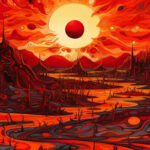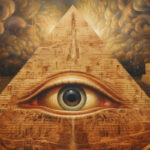Isaac Asimov, the prolific writer and biochemist, was a renowned author of science fiction and popular science books. His contribution to the literary world was immense, and his works continue to inspire and captivate readers even today. In this article, we’ll take a closer look at Asimov’s life and legacy, his most iconic book series, and which ones you should add to your reading list.

The Life and Legacy of Isaac Asimov
Isaac Asimov was born on January 2, 1920, in Petrovichi, Russia. His parents were Jewish, and they immigrated to the United States when Asimov was just three years old. Asimov’s love for reading and writing was evident from an early age, and he went on to study chemistry at Columbia University. However, it was his passion for science fiction that won out in the end, and he became one of the most celebrated authors in the genre.
Early Life and Education
Asimov was a voracious reader from an early age, devouring books from his father’s shop. His parents emphasized his education, and his father’s love for science spurred his interest in the subject. Asimov attended Boys High School and then went on to study chemistry at Columbia University. He started writing science fiction stories while still in college, and after obtaining his doctorate in biochemistry, he decided to devote himself full-time to writing.
Asimov’s Prolific Writing Career
Asimov’s writing career was nothing short of prolific; he wrote more than 500 books during his lifetime, spanning multiple genres. His most famous works were his science fiction novels, which ranged from short stories to sprawling book series. Asimov’s writing style was clear, concise, and to the point, making science understandable and accessible to everyone.
The Influence of Asimov’s Work on Science Fiction
Isaac Asimov’s influence on the science fiction genre is undeniable. His writing was unique in that he blended science with storytelling, creating a new genre that would go on to win awards and critical acclaim. Asimov’s work was also hailed for its positive portrayal of science and scientific progress, which was a significant departure from the dystopian view of science fiction at the time.
The Foundation Series
Asimov’s most iconic and well-known series is the Foundation series. This series is set in the future, where humans have colonized the galaxy, and the great Empire is on the verge of collapse. The series follows the exploits of a group of scientists who hope to preserve the accumulated knowledge of humanity as the Empire falls.
The Premise and Setting
The Foundation series is set in a future where humanity has colonized the galaxy, and Earth is a distant memory. In this future, the Empire has been dominant for thousands of years, but it is in decline. Hari Seldon, a mathematician, has developed a new form of mathematics that can predict history accurately. He uses this knowledge to predict the Empire’s downfall and sets in motion a plan to limit the amount of time spent in the dark ages following the Empire’s collapse.
The Key Books in the Series
The Foundation series is comprised of seven novels and several short stories. The most famous books in the series are “Foundation,” “Foundation and Empire,” and “Second Foundation.” These books follow the trials and tribulations of the scientists trying to preserve mankind’s knowledge while navigating the political machinations and wars whirling around them.
The Impact of the Foundation Series on Science Fiction
The Foundation series is one of the most influential science fiction series of all time. It has inspired countless writers and spawned an entire subgenre of science fiction. The series’ emphasis on political maneuvering, scientific discovery, and grand ideas has influenced generations of science fiction authors and continues to captivate readers today.
The Robot Series
The Robot series is another of Asimov’s iconic book series. The books in this series are set in the same universe as the Foundation series and revolve around the three laws of robotics.
Asimov’s Three Laws of Robotics govern how robots behave in the universe he created. They are:
- A robot may not injure a human being or, through inaction, allow a human being to come to harm.
- A robot must obey the orders given it by human beings, except where such orders would conflict with the First Law.
- A robot must protect its own existence as long as such protection does not conflict with the First or Second Laws.
The Three Laws of Robotics have become a staple in science fiction and have influenced the way people think about artificial intelligence. Asimov’s books explore the implications of these laws and how they affect the relationship between humans and robots.
The I, Robot Collection
The I, Robot collection is a series of interconnected short stories that explore the three laws of robotics. The collection introduces the character of Susan Calvin, a robopsychologist who advises on the use of robots in society.
The stories in the collection are set in different time periods and explore different aspects of the Three Laws. Some of the stories focus on the unintended consequences of the laws, while others explore the ethical implications of creating intelligent machines that are bound by these laws.
The I, Robot collection has been adapted into several films and television shows, including the 2004 movie starring Will Smith.
The Robot Novels
The Robot novels take place later in the timeline. These books explore the continued evolution of robots and the integration of robots into society. One of the most famous books in the series is “The Caves of Steel,” which follows the detective Elijah Baley and his robot partner R. Daneel Olivaw as they investigate a murder on a planet where robots and humans coexist.
The Robot novels also introduce new characters and explore different themes. Some of the books focus on the conflict between robots and humans, while others explore the relationship between robots and their creators.
Overall, the Robot series is a thought-provoking exploration of the relationship between humans and machines. Asimov’s Three Laws of Robotics have become a touchstone for science fiction and continue to influence the way people think about artificial intelligence today.
The Galactic Empire Series
The Galactic Empire series is one of the most fascinating book series set in Isaac Asimov’s overarching universe. The series is a prequel to the Foundation series and explores the beginnings of the empire and the political machinations that will ultimately lead to its downfall. The series is a must-read for anyone who loves science fiction and political intrigue.
The Connection to the Foundation Series
The Galactic Empire series is set thousands of years before the Foundation series. However, the two series are closely tied and inform each other in interesting ways. Characters from the Foundation series, such as Hari Seldon, make appearances in the Galactic Empire series, adding another layer of depth to the overall narrative.
The connection between the two series is a testament to Asimov’s incredible world-building skills. His ability to create a vast and complex universe that spans thousands of years is truly remarkable.
The Stars, Like Dust
The Stars, Like Dust is the first book in the Galactic Empire series and is a fast-paced and exciting adventure story with a dash of political intrigue thrown in for good measure. The book follows the young protagonist Biron Farrill as he becomes embroiled in a political plot that could threaten the wider galaxy.
Asimov’s writing is engaging, and his ability to create compelling characters is on full display in The Stars, Like Dust. The book is a must-read for anyone who loves science fiction and adventure stories.
The Currents of Space and Pebble in the Sky
The Currents of Space and Pebble in the Sky are the two other books in the Galactic Empire series. The Currents of Space is a mystery story set against a backdrop of political machinations, while Pebble in the Sky explores themes of isolationism and the struggle for self-discovery.
Asimov’s ability to blend genres seamlessly is one of the reasons why he is such a celebrated author. His books are not just science fiction stories but are also mysteries, political thrillers, and coming-of-age tales.
The Galactic Empire series is a great example of Asimov’s versatility as a writer. Each book in the series is unique and explores different themes, but they all share the same incredible world-building and character development that Asimov is known for.
In conclusion, Isaac Asimov remains one of the most celebrated authors of science fiction and popular science literature. His contributions to the field of science fiction continue to inspire and captivate readers of all ages. If you’re looking to dive into Asimov’s work, then the Foundation series, the Robot series, and the Galactic Empire series are a great place to start. Asimov’s writing is engaging, and his stories are packed with big ideas that will keep you thinking long after you’ve finished reading.
FAQs
Why is Isaac Asimov famous?
Isaac Asimov is known as one of the most famous and innovative science fiction writers of the 20th century. His books were engaging and very immersive, but also contained a breadth of scientific accuracy that has been used to advance the scientific fields of robotics and artificial intelligence.
Asimov was one of the ‘Big 3’ science fiction writers of his time. He, alongside Arthur C. Clarke and Robert Heinlein, created the most popular science fiction novels in this era.
What has Issac Asimov written?
Issac Asimov was known for the Foundation series and his books on robotics. His most popular books included Profession, The End of Eternity, The Bicentennial Man, and Nightfall.
- The 11 Best Books About Cats You Should Read - January 16, 2024
- The 9 Best Books on Building Confidence - January 16, 2024
- Discover the 10 Best Books on the Brain - January 16, 2024



